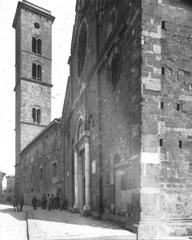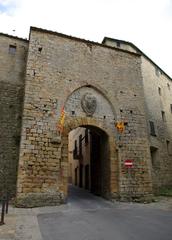
Guarnacci Museum Volterra: Visiting Hours, Tickets, and Historical Sites Guide
Date: 04/07/2025
Introduction
Situated in the heart of Volterra, Tuscany, the Guarnacci Museum is one of Europe’s oldest public museums and a centerpiece for the exploration of Etruscan civilization. Founded in the 18th century and enriched by the collections of Canon Pietro Franceschini and Monsignor Mario Guarnacci, the museum preserves thousands of artifacts—from funerary urns and bronzes to jewelry and pottery—offering a vivid portrait of Etruscan society from its origins through the Roman era. Visitors can immerse themselves in this remarkable legacy within the historic Palazzo Desideri Tangassi, experiencing one of Italy’s most significant archaeological collections while enjoying modern amenities and accessibility. Whether you are a scholar, history enthusiast, or curious traveler, the Guarnacci Museum provides a comprehensive journey into the mysteries of the Etruscans and the enduring impact of their culture on Tuscany and beyond (Live the World; Ancient Lore Quest; Visit Tuscany; Volterra Tourism).
Table of Contents
- History and Origins of the Guarnacci Museum
- Volterra’s Etruscan Heritage
- Highlights of the Guarnacci Collection
- Visiting Information
- Architectural and Scientific Significance
- Frequently Asked Questions (FAQ)
- Visual Highlights
- Travel Tips and Summary
- References
History and Origins of the Guarnacci Museum
The Guarnacci Museum traces its origins to 1761, when Monsignor Mario Guarnacci, an eminent scholar and collector, donated his vast assemblage of Etruscan, Roman, and prehistoric artifacts to Volterra, stipulating their public accessibility. This foundational act, combined with discoveries such as Canon Pietro Franceschini’s unearthing of forty Etruscan urns from a hypogeum in 1776, anchored the museum as a guardian of local heritage (Ancient Lore Quest). Housed since 1877 in Palazzo Desideri Tangassi, the museum’s collection has expanded through subsequent archaeological finds, establishing it as a pillar for Etruscan studies and public education (volterra.net; wikipedia).
Volterra’s Etruscan Heritage
Volterra, ancient Velathri, was a major Etruscan city-state and religious center. Archaeological evidence reveals continuous habitation from the Middle Bronze Age, with the city’s prominence reflected in its necropolises, city walls, and monumental gates. Roman conquest introduced new layers of cultural influence, but the Etruscan legacy remains tangible, especially through the artifacts preserved in the Guarnacci Museum (Ancient Lore Quest; Visit Tuscany).
Highlights of the Guarnacci Collection
Funerary Urns and Sarcophagi
The museum is famed for its unparalleled collection of over 600 Etruscan funerary urns, crafted primarily from alabaster, terracotta, and stone between the 4th and 1st centuries BCE. The urns’ elaborately carved lids often depict reclining figures at banquets—a motif symbolizing beliefs about the afterlife and the social roles of women. Many urns bear inscriptions in the Etruscan language, providing unique insights into family, society, and religion (volterratur.it; volterra.net).
Bronzes and Iconic Works
Among the museum’s masterpieces is the renowned “Ombra della Sera” (“Shadow of the Evening”), a bronze statuette dating to the 3rd century BCE. Its elongated, modernist form has become a symbol of Volterra. Other notable bronzes include votive statuettes, mirrors, and ceremonial objects that reflect the technical skill and creativity of Etruscan artisans (terredipisa.it; Live the World).
Pottery, Jewelry, and Everyday Objects
The museum’s pottery collection features both local and imported Greek wares, illustrating Volterra’s role as a trade hub. Etruscan jewelry in gold, silver, and bronze highlights the region’s artistic sophistication. Everyday objects, including tools and domestic goods, enrich the narrative of daily life in ancient Volterra (volterra.net).
Additional Highlights
- Stele of Avile Tite: A 6th-century BCE funerary stele blending Etruscan and Greek-Oriental styles.
- Urna degli Sposi (“Urn of the Bride and Groom”): An expressive late Hellenistic alabaster urn portraying an elderly couple at a banquet.
- Early Iron Age Finds: Burial goods, weapons, and pottery from the Badia and Guerruccia necropolises.
- Coins and Numismatics: Thousands of coins from Etruscan, Greek, and Roman periods.
- Reconstructed Tombs: Rooms displaying original burial furnishings and reconstructions of family tombs (invitationtotuscany.com).
Visiting Information
Opening Hours
- Tuesday to Sunday: 9:00 AM – 7:00 PM (last admission at 6:30 PM)
- Closed: Mondays and major holidays (Earth Trekkers; comune.volterra.pi.it)
Ticket Prices and Volterra Card
- Adults: €8
- Reduced: €5 (EU citizens aged 18–25)
- Free: Children under 18, Volterra residents, EU citizens over 65, museum professionals
- Combined ticket: The Volterra Card (€20, valid 72 hours) grants access to multiple city sites including the Guarnacci Museum, Roman Theater, Palazzo dei Priori, and more (Earth Trekkers).
- Where to buy: At the museum entrance or participating sites; some online purchase options are available.
Accessibility and Visitor Facilities
- The museum is generally accessible, with ramps and an internal elevator. Some areas may have uneven floors; visitors with mobility needs are encouraged to contact the museum in advance.
- Facilities include restrooms and a gift shop; there is no on-site café, but dining options are nearby in Volterra’s center.
Guided Tours and Special Events
- Guided tours in several languages (including English and Italian) can be booked in advance or onsite.
- Special exhibitions and cultural events take place throughout the year—check the official website or Volterra Tourism for current schedules.
Directions and Nearby Attractions
- Address: Via Don Giovanni Minzoni, 15, Volterra
- By bus: Accessible from Pisa, Florence, and Siena
- Parking: Available outside the historic center; museum is a short walk from parking lots
- Nearby sites: Roman Theater, Palazzo dei Priori, Etruscan city walls and gates, Volterra Cathedral (Earth Trekkers).
Architectural and Scientific Significance
The Guarnacci Museum’s home, Palazzo Desideri Tangassi, enhances the visitor experience with its blend of historic architecture and modern exhibition design. The museum has played a central role in the study of Etruscan civilization, attracting scholars worldwide. Its collections have contributed to advances in archaeological, linguistic, and historical research, and its educational programs make Etruscan culture accessible to all audiences (wikipedia; volterratur.it).
Frequently Asked Questions (FAQ)
Q: What are the Guarnacci Museum’s visiting hours?
A: Tuesday to Sunday, 9:00 AM – 7:00 PM; closed Mondays and holidays.
Q: How much do tickets cost?
A: Adults €8; reduced €5 for EU citizens aged 18–25; free for children under 18, residents, and EU citizens over 65.
Q: Is the museum accessible for visitors with disabilities?
A: Yes, with ramps and elevator; some areas may be challenging—contact the museum for specific needs.
Q: Are guided tours available?
A: Yes, in multiple languages; booking in advance is recommended.
Q: Can I take photos inside?
A: Non-flash photography is generally allowed; tripods and flash are prohibited.
Visual Highlights
- Ombra della Sera:
- Museum Exterior:
Travel Tips and Summary
- Duration: Allocate 1–2 hours for a thorough visit.
- Language: Most labels are in Italian; bring a guidebook or use translation apps for deeper understanding.
- Peak times: Visit early or late in the day to avoid crowds; weekdays are quieter than weekends.
- Volterra Card: Consider purchasing for savings if visiting multiple sites.
- Combine sites: The museum’s central location allows easy access to other Volterra attractions.
The Guarnacci Museum encapsulates the essence of Etruscan civilization and Volterra’s enduring identity, making it an essential stop for cultural travelers and history lovers alike. Plan ahead, make use of digital resources such as the Audiala app, and enrich your journey through Tuscany’s ancient heritage.
References
- Live the World
- Ancient Lore Quest
- Visit Tuscany
- Volterra Tourism
- terredipisa.it
- Earth Trekkers
- volterra.net
- wikipedia
- invitationtotuscany.com
- comune.volterra.pi.it
- Love from Tuscany
- whichmuseum.com
- budgetyourtrip.com
- indaginiemisteri.it
For up-to-date information, ticket bookings, and exclusive tours, visit the official museum website or Volterra tourism page. Download the Audiala app for digital guides and follow us on social media for news and events.



